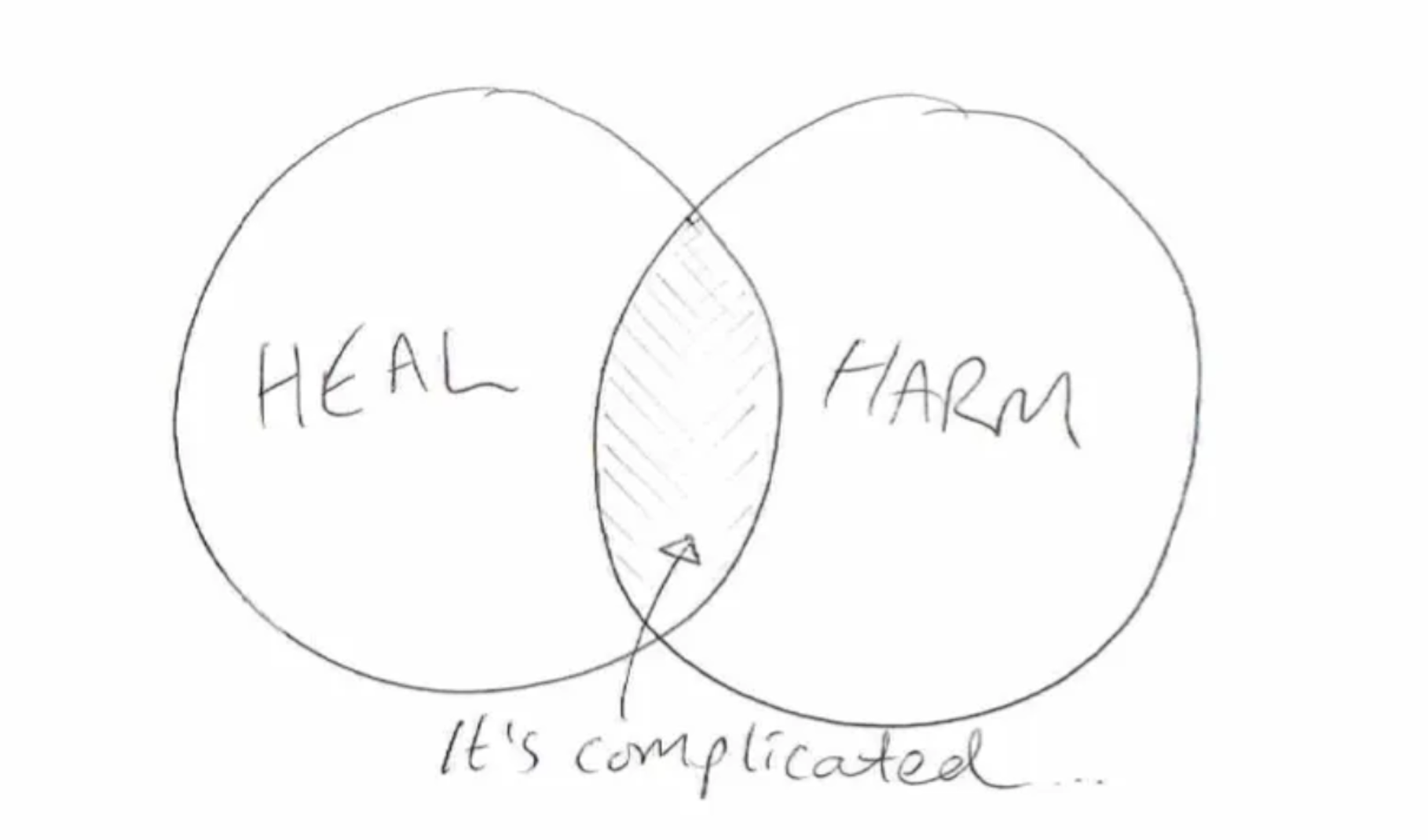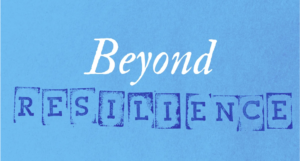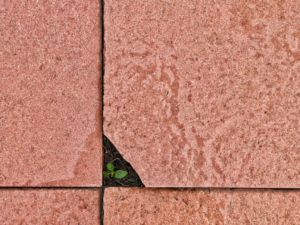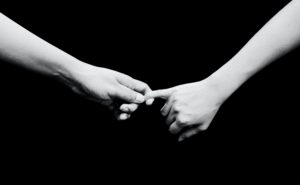It’s a peculiarity of humans that the things we do can hurt and heal us simultaneously and that we can be unaware of either of those things happening.
It’s like a fuzzy, moving Venn diagram (just imagine those circles are bubbles changing their positions and their overlap moment to moment)
And it’s complicated because sometimes we feel like we have to go through the harm to get to the healing.
For example:
1) A familiar, widespread example: at what point does sitting down for 8, 10, 12 hours+ a day for weeks or months or years (because you really want a particular exam result or because your job requires it) become self-harm — because of the mental and emotional pressure you put on yourself, the damage done physically and metabolically from being sedentary, and perhaps damage to eyesight from close up work and strain, and potential social isolation? But we do it because the intention and outcome are believed to be of sufficient value to justify the negative consequences.
2) A(nother apparently) starker example: what about a person who cuts themselves to regulate their feelings? It’s commonly thought that self-cutting as popularly understood is a ‘cry for help’ or indication of suicidal intentions. But this isn’t always the case. Another reason for self-cutting is to try to regulate difficult emotions and regain control over one’s emotional, mental and physical environment — the closest, most controllable, environment being (at that moment) one’s own body, i.e. it is done in order to be, and manage being, alive — even though the consequences can be severe.
This is an example of the therapeutic principle that every behaviour has a positive intention. The primary goal of the mind is to get the organism to survive. So when we see behaviours that can be read as self-destructive it’s because the mind has a) judged there is no better action available to take, and/or b) learned that this is what is done in this situation, i.e. somewhere along the line it’s made a calculation error but is acting in good faith.
3) A sports example — aka why we get caught in our heroes’ mistakes: What about athletes who train to and through injuries to try to achieve the performance outcome they’ve been working for? They often get praise for doing this, for being tough, and dedicated. Sometimes there’s validity in giving this praise. But if you get to your goal by breaking your (physical, mental, emotional) tools meaning that you are no longer able to achieve such things, is this really an outright victory? Depending on your goal it may be worth it, or if the outcome is a once in a lifetime chance. But if your goal is long-term full participation, then it’s unlikely to be a wise call.
For example, it is common for boxers and those practicing other striking arts to cause damage to a wrist due to landing a shot at an odd angle, which is something I have first hand experience of. I’m lucky, my wrist made a reasonable recovery, but initially I was unable to open doors, turn taps or twist the lids of jars. I damaged my tools, which affected my ability to engage with my sport and conduct my life. But after some degree of recovery I resumed striking, even though my wrist was in pain and I was risking future problems, because of the benefit I was getting to the rest of my life from practicing my sport.
Don’t stub your toe on the pedestals you’ve made
Several of my instructors, who have achieved incredible things, have trained so hard that before age 40 they’ve had hip replacements, which now significantly limit their practice.
Here’s the question: in order to be able to ‘win’ for 20 years would you accept walking, sitting, standing, lying with pain from age 40 until you die, and never being able to ‘win’ like that again?
For you it may be a ‘yes’. Others may see this type and effect of training as self-harm, an indication of a lack of balance in your life and your mind, a destructive drive to ‘try to prove you’re (not) xyz’, which can take you a long way but irreparably damage you along that way.
And what of the student looking up at the teacher, thinking ‘to be that good, I need to do those things’ or ‘she did it so it’s OK if I do it’?
Sylvester Stallone in his book Sly Moves recounts stories of his brutal training and dieting and states “Overtraining wasted thousands of hours of my life” because he didn’t know better at the time. The story of the rest of the book being that he was sharing his successes and failures so that the reader didn’t have to repeat his mistakes.
Be Better Than Your Heroes
We are each responsible for not copying the mistakes of our teachers and our heroes. But it can be difficult to know what those mistakes are, especially when in our own models of the world we believe, for example, that ‘suffering is necessary for greatness’, or ‘you’ve got to suffer to be beautiful’, or any number of things which may be less than helpful to us.
These, our stories, are filters through which we see the world and against which we judge ourselves. As we’ve mentioned Stallone already, let’s consider Rocky: is a boxer who takes that much of a beating before fighting back effectively really the best example for a real boxer to emulate?
I grew up with heroes who could never share their lives or their truth with anyone else because their power and responsibilities meant that it put themselves, others, or the world in danger. I operated according to (a much less grandiose version of!) this principle for years: if I want to achieve great things then I can’t be close to others. This led to a long list of achievements, and a short list of friends and relationships.
And popular cultures reinforce this idea that success necessitates isolation. The lone wolf. The silent warrior. The outcast. The ronin. This is so embedded in our stories as to make my experience far far from unique. And it doesn’t have to be true or necessary. Because there are other stories out there: versions of ‘behind every great man is a great woman’, ‘stand on the shoulders of giants’, ‘no man is an island’ and so on. But my mind, as all our minds do, selected evidence through and in support of the filter of my pre-existing beliefs (often referred to as Orr’s Law: ‘What The Thinker thinks, The Prover proves’). I just didn’t take in any other message — until my thinking got overwhelmingly disrupted by specific points in the process.
The body as a bridge to the soul
A friend and I were talking about this overlap of self-healing and self-harming as she has recently taken up serious running as an antidote to addiction, and I noted that I experienced the body as a bridge to the soul.
She’s not a natural runner and I’m not a natural martial artist, and whilst I gained many benefits to my life through training, through the years I also took damage to my face leading to dental and facial surgery.
You can’t tell on the outside looking in, but on the inside I can feel it. And just as the process of consistent training year in year out teaches so much more than the front face of the discipline might show to the general public, dealing with injuries and what they mean to and for you can be enlightening.
For me the biggest thing, the ‘best technique’ (because people do ask…) I learned from martial arts, from training to, through, and with injuries was compassion. Because over time I learned not just to withstand but how to standwith — myself and others who were also going through similar experiences.
Without this physical practice I would not have experienced these metaphysical changes, which have been of such benefit to me and also through me to others. And I know I’m in good company here as humans have known and practiced this for centuries.
Self-harm → Self-harmony
In sport as in life ‘pain is inevitable but suffering is optional’, and as guides and teachers to ourselves and others we can be more enlightened, skillful, and effective in our approaches to transformation and growth.
There are many exercises for this that I have used myself and use with my clients, so here is a short set of steps that you can use right now. Complete each step before reading the next. If you just read them they may seem simple but, like most things, the magic lies in the doing.
Think about something you do that feels essential to you, like an expression of a core part of who you are or who you want or need to be, and which you get the feeling might fit into this process of self-harm/ony:
1) Consider in what ways it’s healing you and in what ways it’s harming you
2) Consider why it’s important to you to do it
3) Do this abbreviated version of the Trackdown exercise from Trevor Silvester (therapist and founder of The Quest Institute) by answering these questions:
i) What was your favourite story, film or game when you were growing up?
ii) Describe your understanding of the story or theme
iii) What is your favourite book or film now?
iv) What are the similarities in the two stories?
v) What are the similarities between those things that the two have in common and your own life so far?
vi) How would you finish these three sentences:
I am OK if…
I am OK when…
I am not OK when….
vii) How are the things that you have written about above linked to the themes of your favourite story and film?
4) Just take a moment now to imagine that you could get the benefits you want, without the harm, and just allow your mind to come up with any ideas about ways this could be possible. Just be curious about it. And how you could use these things as the basis for change. You might be surprised what comes to mind.
As always, if this brings up anything difficult for you, or brings up something interesting, and if you would like to explore things further then consider working with a qualified therapist or coach as they will have tools that can help this process.
Thanks for reading. If this has been helpful to you then feel free to let me know. And if you found it interesting then please feel free to share it so other people can find and enjoy it too.
(Originally published on Medium in 2016 https://medium.com/@eveparmiter/self-harm-ony-978a53576fd3)



